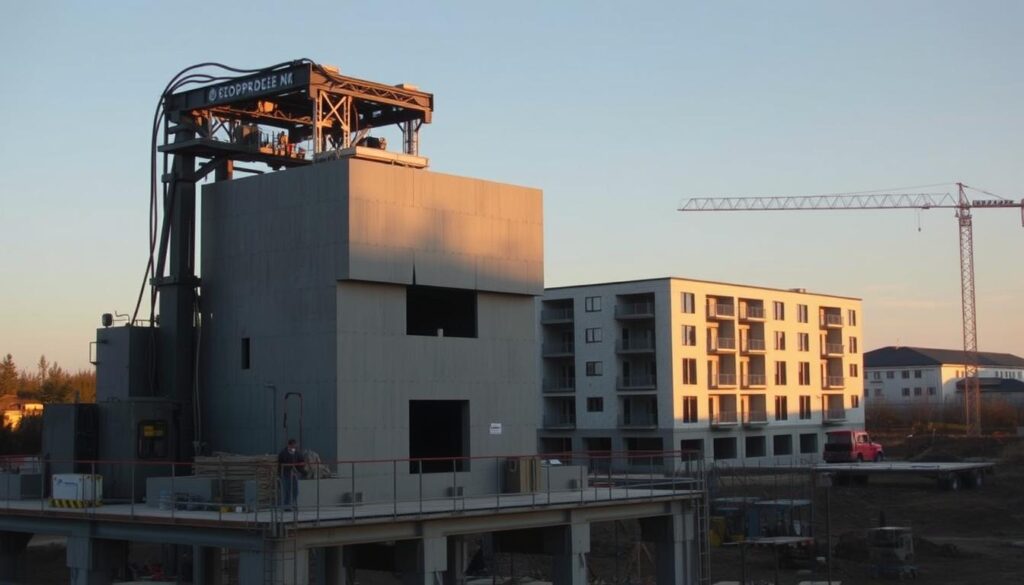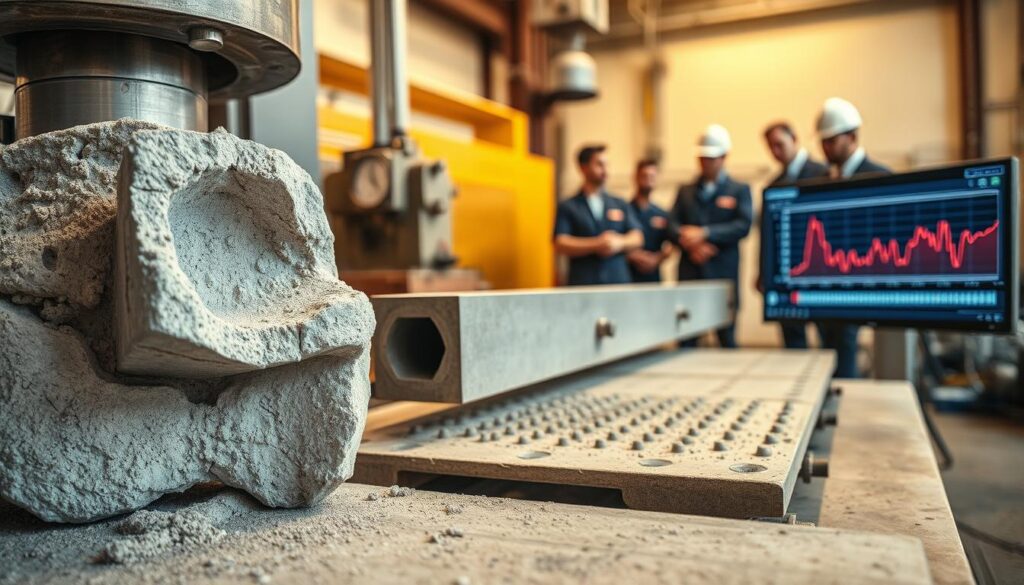The United States is witnessing a significant transformation in the field of civil engineering advancements, driven by the development of innovative materials and technologies. The impact of these advancements is profound, with the potential to revolutionize the way infrastructure is designed, constructed, and maintained.
The Materials Innovation Platforms (MIP) program is a notable example, focusing on accelerating advances in materials research through interdisciplinary teams. Additionally, the use of sustainable building materials is becoming increasingly important, reducing environmental impact and enhancing durability.
Key Takeaways
- Innovative materials are transforming the construction industry.
- The MIP program supports cutting-edge materials research.
- Sustainable practices are crucial for future infrastructure development.
- Eco-friendly materials reduce environmental impact.
- Advanced materials enhance durability and efficiency.
Overview of Civil Engineering Innovations
The landscape of civil engineering is undergoing a significant transformation, driven by innovative materials and cutting-edge technologies. This shift is not only enhancing the durability and performance of infrastructure but also contributing to more sustainable and environmentally friendly construction practices.
Importance of Modern Materials
Modern materials are at the forefront of civil engineering innovations, offering enhanced strength, durability, and sustainability. Innovative materials engineering has led to the development of materials that can withstand extreme conditions, reducing the need for frequent repairs and replacements.
The use of cutting-edge construction materials such as high-performance concrete, advanced composites, and smart materials is revolutionizing the construction industry. These materials are designed to provide improved mechanical properties, durability, and resistance to environmental degradation.
Impact on Construction Practices
The impact of modern materials on construction practices is profound. With the ability to create complex structures that were previously impossible to build, modern materials are expanding the possibilities of civil engineering.
| Material | Benefits | Applications |
|---|---|---|
| High-Performance Concrete | Enhanced strength, durability | High-rise buildings, bridges |
| Advanced Composites | Lightweight, corrosion-resistant | Aerospace, automotive, construction |
| Smart Materials | Self-healing, responsive to environmental changes | Structural health monitoring, adaptive infrastructure |
The integration of these materials into construction practices is not only improving the quality and longevity of infrastructure but also contributing to more sustainable and efficient construction processes.
Leading Material Innovations in the USA

The USA is at the forefront of developing cutting-edge civil engineering materials, driving progress in construction practices and infrastructure development. This leadership is largely attributed to significant advancements in various material technologies.
One of the key areas of innovation is in the development of high-performance concrete. This advanced material is engineered to offer superior strength and durability compared to traditional concrete. Its applications range from high-rise buildings to complex infrastructure projects, enhancing the longevity and safety of structures. For instance, high-performance concrete is being used in bridge construction, as seen in projects highlighted on World Civil Society, where innovative materials are revolutionizing bridge building techniques.
High-Performance Concrete
High-performance concrete is characterized by its enhanced mechanical properties and durability. It is designed to withstand harsh environmental conditions, reducing the need for frequent repairs and maintenance. This not only improves the lifespan of structures but also contributes to cost savings over time.
Smart Materials
Another significant innovation is the development of smart materials. These materials are capable of responding to external stimuli, such as temperature or stress, allowing for real-time monitoring and adaptation. Smart materials have the potential to revolutionize the construction industry by enabling the creation of structures that can adapt to changing conditions, thereby enhancing their resilience and performance.
Recycled Materials
The use of recycled materials is gaining prominence as a sustainable practice in civil engineering. By reusing materials from demolition sites or industrial by-products, the construction industry can significantly reduce waste and lower its environmental footprint. Recycled materials are being increasingly used in various applications, from aggregate in concrete to fillers in asphalt, promoting a more circular economy.
The integration of these advanced materials into civil engineering projects is transforming the landscape of construction in the USA. As research continues to advance, we can expect to see even more innovative applications of these materials, further enhancing the sustainability and efficiency of construction practices.
Sustainable Materials in Civil Engineering
As the world grapples with environmental challenges, civil engineering is turning to sustainable materials to mitigate its impact. The development and use of such materials are crucial for reducing the ecological footprint of construction projects.
Green Concrete Solutions
Traditional concrete is a significant contributor to greenhouse gas emissions due to its high cement content. Green concrete solutions aim to reduce this impact by incorporating supplementary cementitious materials (SCMs) such as fly ash, slag, and silica fume. These materials not only reduce the amount of cement needed but also improve the durability and strength of the concrete.
Biodegradable Materials
The use of biodegradable materials in civil engineering is gaining traction as a sustainable alternative to traditional construction materials. These materials, which can range from bioplastics to natural fibers, offer the potential to significantly reduce waste and environmental harm.
Energy-Efficient Insulation
Energy-efficient insulation is critical for reducing the energy consumption of buildings. New materials and technologies are being developed to provide better insulation, thereby minimizing heat loss in the winter and heat gain in the summer. This not only reduces the need for heating and cooling but also lowers greenhouse gas emissions.
The adoption of these sustainable materials is not just beneficial for the environment; it also offers long-term economic benefits through reduced energy costs and extended material lifespan.
Advances in Construction Technology

The construction industry is on the cusp of a revolution, driven by groundbreaking civil engineering materials and United States materials engineering solutions. As the industry continues to evolve, new technologies are being adopted to improve efficiency, reduce costs, and enhance the quality of construction projects.
One of the most significant advancements in construction technology is the adoption of 3D printing techniques. This innovative method allows for the creation of complex structures with unprecedented precision and speed. For instance, a study by the Claris Design Build highlights the potential of 3D printing in construction, showcasing its ability to reduce material waste and improve construction timelines.
3D Printing Techniques
3D printing in construction involves the use of large-scale printers that can create walls, buildings, and other infrastructure components. This technology has the potential to revolutionize the construction industry by reducing labor costs, improving safety, and enabling the creation of complex geometries that would be difficult or impossible to achieve with traditional construction methods.
For example, a company in the United States has successfully used 3D printing to construct a series of complex architectural features, demonstrating the potential of this technology to transform the construction process.
Modular Construction Innovations
Modular construction is another area where significant advancements are being made. This approach involves the fabrication of building modules in a factory, which are then transported to the construction site for assembly. Modular construction can significantly reduce on-site labor costs, improve quality control, and minimize the environmental impact of construction projects.
A notable example of modular construction is the use of prefabricated modules in high-rise building projects. By fabricating modules in a controlled factory environment, construction companies can improve the quality and consistency of the building components, leading to a better finished product.
| Modular Construction Benefits | Traditional Construction Methods |
|---|---|
| Reduced on-site labor costs | Higher labor costs due to on-site construction |
| Improved quality control | Quality control challenges on-site |
| Minimized environmental impact | Potential for greater environmental disruption |
Robotics in Construction
Robotics is also being increasingly used in the construction industry to automate tasks, improve safety, and enhance efficiency. Robots can be used for a variety of tasks, including bricklaying, demolition, and material handling. By automating these tasks, construction companies can reduce labor costs, improve productivity, and minimize the risk of accidents on site.
“The use of robotics in construction is expected to grow significantly in the coming years, driven by advances in artificial intelligence and machine learning.”
As the construction industry continues to adopt these new technologies, we can expect to see significant improvements in the efficiency, quality, and safety of construction projects. The integration of United States materials engineering solutions will play a crucial role in this transformation, enabling the development of innovative materials and construction methods that will shape the future of the industry.
Smart Infrastructure and Materials
Advancements in smart infrastructure and materials are transforming the civil engineering landscape, enabling more efficient and sustainable practices. The incorporation of innovative technologies is enhancing the performance, safety, and longevity of infrastructure projects across the United States.
Sensor-Embedded Materials
Sensor-embedded materials are revolutionizing the way infrastructure is monitored and maintained. By integrating sensors into construction materials, engineers can track the health of structures in real-time, allowing for proactive maintenance and reducing the risk of failures. For instance, a smart building in Chicago has successfully implemented sensor-embedded materials to monitor its structural integrity.
IoT Integration in Infrastructure
The Internet of Things (IoT) is playing a crucial role in modernizing infrastructure. By connecting infrastructure to the digital world, IoT integration enables more efficient management and operation of civil engineering projects. This connectivity facilitates the collection of data on various parameters, such as traffic flow, environmental conditions, and structural health, thereby optimizing infrastructure performance.
Predictive Maintenance Technologies
Predictive maintenance technologies are being increasingly adopted in civil engineering to anticipate and prevent maintenance needs. By leveraging data analytics and machine learning algorithms, these technologies can predict potential failures, allowing for timely interventions. This proactive approach reduces downtime, extends the lifespan of infrastructure, and minimizes maintenance costs.
| Technology | Application | Benefits |
|---|---|---|
| Sensor-Embedded Materials | Real-time monitoring of infrastructure health | Proactive maintenance, reduced risk of failures |
| IoT Integration | Connecting infrastructure to the digital world | Efficient management, optimized performance |
| Predictive Maintenance | Anticipating and preventing maintenance needs | Reduced downtime, extended infrastructure lifespan |
The integration of smart infrastructure and materials is a significant step forward in civil engineering, offering numerous benefits, including enhanced performance, safety, and sustainability. As these technologies continue to evolve, they are expected to play an increasingly vital role in shaping the future of infrastructure development.
Role of Nanotechnology in Civil Engineering

Nanotechnology is playing a crucial role in advancing civil engineering by introducing innovative materials and solutions. The integration of nanotechnology in construction is leading to significant improvements in material durability, safety features, and sustainability.
Enhancing Material Durability
Nanomaterials are being used to enhance the durability of construction materials, improving their resistance to degradation and damage. For instance, the incorporation of nanoparticles in concrete can significantly enhance its strength and durability. According to a study published on PMC, the use of nanomaterials in concrete can lead to improved mechanical properties.
- Nanoparticles improve the density of concrete, reducing its permeability and enhancing its resistance to chemical attacks.
- Nanomaterials can also be used to create self-healing materials that can repair cracks autonomously.
Improved Safety Features
The use of nanotechnology in civil engineering is also leading to improved safety features. Advanced coatings and materials with enhanced properties are being developed to improve the safety of infrastructure. For example, nanomaterials can be used to create coatings that are resistant to corrosion and wear, enhancing the lifespan of construction materials.
Key benefits include:
- Enhanced resistance to environmental degradation
- Improved mechanical properties
- Self-healing capabilities
Nanomaterials for Sustainability
Nanomaterials are also being used to promote sustainability in civil engineering. The use of nanomaterials can reduce the environmental impact of construction materials and improve their recyclability. For instance, nanomaterials can be used to develop more efficient insulation materials, reducing energy consumption in buildings.
Some of the ways nanomaterials are promoting sustainability include:
- Reducing the amount of material needed for construction
- Improving the energy efficiency of buildings
- Enhancing the recyclability of construction materials
Legislation and Standards Impacting Innovations
Legislation and standards play a crucial role in shaping the future of civil engineering by ensuring that innovations meet safety and environmental standards.
The civil engineering industry is heavily regulated to ensure that new materials and technologies are safe, sustainable, and meet the required performance standards. This regulatory framework includes building codes, environmental regulations, and industry standards for materials.
Building Codes and Compliance
Building codes are critical in ensuring that new constructions and renovations meet minimum safety standards. Compliance with these codes is mandatory, and it involves rigorous testing and certification of materials and technologies.
For instance, the International Building Code (IBC) and the International Residential Code (IRC) are widely adopted in the USA. These codes specify requirements for various aspects of construction, including structural integrity, fire resistance, and energy efficiency.
Environmental Regulations
Environmental regulations are designed to minimize the ecological footprint of construction activities. These regulations cover aspects such as waste management, pollution control, and the use of sustainable materials.
The Environmental Protection Agency (EPA) plays a significant role in enforcing environmental regulations in the USA. The EPA sets standards for environmental impact assessments and promotes the use of green technologies.
Industry Standards for Materials
Industry standards for materials ensure consistency and quality across the civil engineering sector. These standards are developed by organizations such as the American Society for Testing and Materials (ASTM) and the American Concrete Institute (ACI).
Standards for materials cover various properties, including strength, durability, and chemical composition. Compliance with these standards is essential for ensuring the reliability and performance of construction materials.
| Standard | Description | Organization |
|---|---|---|
| ASTM C150 | Standard Specification for Portland Cement | ASTM |
| ACI 318 | Building Code Requirements for Structural Concrete | ACI |
| IBC | International Building Code | International Code Council |
In conclusion, legislation and standards are pivotal in guiding the development and adoption of innovations in civil engineering. By ensuring compliance with building codes, environmental regulations, and industry standards, the industry can continue to advance while maintaining safety, sustainability, and performance.
Case Studies of Successful Innovations

Innovative materials have transformed the landscape of civil engineering, enabling the construction of more durable and sustainable structures. Several notable projects have successfully utilized these materials, providing valuable lessons and insights for future applications.
Notable Projects Using Innovative Materials
Projects such as the Panama Canal expansion and the Central Park Tower have demonstrated the potential of innovative materials in civil engineering. The Panama Canal expansion utilized advanced concrete technologies to enhance durability and reduce maintenance needs. Similarly, the Central Park Tower incorporated cutting-edge materials and construction techniques to achieve unprecedented heights and structural integrity.
Another example is the use of advanced composites in bridge construction, such as in the New York City’s Governor Mario M. Cuomo Bridge. These materials have improved the structural performance and longevity of the bridge, reducing the need for frequent repairs.
Lessons Learned from Implementations
The successful implementation of innovative materials in these projects has provided several key lessons. Firstly, the importance of careful planning and collaboration among stakeholders cannot be overstated. Additionally, rigorous testing and validation of new materials are crucial to ensure their performance and safety in real-world conditions.
A study published in a recent issue of the International Journal of Scientific and Research Applications highlights the significance of adopting innovative in infrastructure projects, citing improvements in sustainability and cost-effectiveness.
| Project | Innovative Material Used | Benefits |
|---|---|---|
| Panama Canal Expansion | Advanced Concrete | Enhanced Durability, Reduced Maintenance |
| Central Park Tower | High-Strength Concrete, Advanced Steel | Increased Structural Integrity, Unprecedented Heights |
| Governor Mario M. Cuomo Bridge | Advanced Composites | Improved Structural Performance, Longevity |
Future Trends in Civil Engineering Materials
As we look ahead, the role of innovative materials in shaping the future of civil engineering becomes increasingly evident. The United States is witnessing a significant shift towards the adoption of groundbreaking civil engineering materials that promise to revolutionize construction practices.
Anticipated Material Advancements
The future of civil engineering is closely tied to advancements in material science. New high-performance materials are being developed to meet the increasing demands of modern infrastructure projects. These materials are not only stronger and more durable but also more sustainable.
Key advancements include:
- Development of ultra-high performance concrete
- Increased use of fiber-reinforced polymers
- Advances in nanotechnology for enhanced material properties
Influence of Climate Change
Climate change is driving the need for more resilient and sustainable materials in civil engineering. The focus is on developing materials that can withstand extreme weather conditions and reduce environmental impact.
| Material | Climate Change Mitigation | Resilience |
|---|---|---|
| Green Concrete | Reduced carbon footprint | Enhanced durability |
| Recycled Materials | Reduced waste | Improved sustainability |
Digital Twin Technology in Material Development
Digital twin technology is emerging as a critical tool in the development and testing of new materials. By creating virtual replicas of materials and infrastructure, engineers can simulate various conditions to predict performance and identify potential issues early on.
The benefits of digital twin technology include:
- Reduced material waste through optimized testing
- Improved material performance through simulated stress testing
- Enhanced collaboration between designers, engineers, and stakeholders
The integration of these trends is set to transform the landscape of civil engineering in the United States, driving innovation and sustainability in the construction industry.
Collaborative Efforts in Material Research

The landscape of civil engineering in the USA is being reshaped by the synergy between academia, industry, and government entities, driving innovation in material science. State-of-the-art civil engineering materials innovation USA is the result of effective collaboration between various stakeholders.
Partnerships between Academia and Industry
Collaborations between universities and industry leaders are fostering an environment where new materials and technologies can be developed and tested. For instance, research partnerships have led to the creation of advanced concrete materials that are both durable and sustainable.
High-performance concrete, for example, has seen significant advancements due to these collaborations. This material is not only stronger but also more environmentally friendly, reducing the carbon footprint of construction projects.
Government Funding Initiatives
Government initiatives play a crucial role in supporting research and development in civil engineering materials. Funding programs aimed at encouraging innovation have enabled researchers to explore new frontiers in material science.
One notable example is the funding provided for research into smart materials that can adapt to environmental changes, enhancing the safety and efficiency of infrastructure.
Research and Development Highlights
The outcomes of these collaborative efforts are evident in the advancements being made in material technology. New materials are being developed with enhanced properties, such as increased strength, durability, and sustainability.
| Material | Property | Application |
|---|---|---|
| High-Performance Concrete | Enhanced Durability | Bridge Construction |
| Smart Materials | Adaptive Properties | Structural Monitoring |
| Recycled Materials | Sustainability | Road Construction |
Challenges in Material Adoption
The integration of innovative materials in civil engineering projects is often hindered by several key challenges. Despite the potential benefits, the adoption of new materials and technologies can be complicated by factors such as cost, industry inertia, and technical constraints.
Cost Implications
One of the primary barriers to the adoption of cutting-edge construction materials is the higher upfront cost associated with these new technologies. While long-term savings can be significant, the initial investment can be a deterrent for many projects.
The cost implications extend beyond the material itself, affecting the overall project budget and potentially influencing the choice of materials used.
Industry Resistance to Change
The construction industry is known for its traditional practices and resistance to change. Adopting new materials requires not only a financial investment but also a willingness to adapt existing practices and workflows.
Education and training are crucial in overcoming this resistance, enabling professionals to understand the benefits and proper application of innovative materials engineering techniques.
Technical Limitations
Technical limitations also play a significant role in the adoption of new materials. Issues such as compatibility with existing structures, scalability of production, and the need for specialized equipment can hinder the widespread adoption of cutting-edge construction materials.
Addressing these technical challenges through research and development is essential for overcoming the barriers to adoption and fully realizing the potential of innovative materials in civil engineering.
The Role of Education in Material Innovations

Education is the backbone of innovation in civil engineering, driving advancements in material science. The integration of cutting-edge knowledge and skills in engineering curricula is crucial for fostering the next generation of civil engineers.
Curriculum Development in Engineering Schools
Engineering schools in the USA are continually updating their curricula to include the latest advancements in civil engineering technology. This includes courses on advanced building materials research and their applications. For instance, universities are now incorporating subjects on sustainable materials and their environmental impacts.
- Inclusion of courses on smart materials and their uses.
- Focus on sustainable practices in construction.
- Emphasis on nanotechnology and its potential in civil engineering.
Encouraging Research Projects
Research projects play a vital role in advancing USA civil engineering technology. By encouraging students to engage in research, engineering schools foster innovation and practical problem-solving skills. These projects often lead to the development of new materials and techniques.
“The future of civil engineering lies in the hands of our students and the research they conduct today.” – Dr. Jane Smith, Professor of Civil Engineering
Some notable research areas include:
- Development of high-performance concrete.
- Investigation into the properties of recycled materials.
- Exploration of smart materials for infrastructure monitoring.
Professional Certifications and Training
Beyond academic education, professional certifications and training are essential for the ongoing development of civil engineers. Programs that focus on advanced building materials and their applications help professionals stay updated with industry advancements.
By combining academic rigor with practical training and professional certifications, the civil engineering sector can ensure that its workforce remains at the forefront of material innovations.
Regional Innovations Across the USA
Across the USA, different regions are pioneering unique civil engineering material innovations tailored to their specific needs. This regional diversity is driving the development of a wide range of materials and technologies that are enhancing infrastructure across the country.
Innovations from California
California is at the forefront of civil engineering innovations, particularly in the area of sustainable materials. The state’s focus on environmental sustainability has led to the development of new materials and technologies that minimize environmental impact. For instance, the use of recycled materials in construction is becoming increasingly popular.
| Material | Application | Benefit |
|---|---|---|
| Recycled Concrete | Road Construction | Reduced Waste |
| Low-Carbon Concrete | Building Foundations | Lower Emissions |
| Advanced Composites | Bridge Repair | Increased Durability |
Developments in the Midwest
The Midwest is also making significant contributions to civil engineering material innovations, with a focus on improving infrastructure resilience. The region’s harsh weather conditions have driven the development of materials that can withstand extreme temperatures and weather events.
Some notable developments include the use of advanced materials in bridge construction and the application of nanotechnology to enhance material durability.
Trends in the Northeast
The Northeast is witnessing a trend towards more sustainable and climate-resilient materials in civil engineering projects. The region’s aging infrastructure has created a need for innovative materials that can be used in repair and rehabilitation projects.
Trends include the use of green infrastructure and the incorporation of energy-efficient materials in building construction.
Importance of Material Testing and Quality Control

The integrity of civil engineering projects hinges on rigorous material testing and quality control measures. Ensuring that materials used in construction meet the required standards is crucial for the safety, durability, and performance of infrastructure.
Testing Methods for Civil Engineering Materials
Various testing methods are employed to evaluate the properties of civil engineering materials. These include:
- Mechanical testing to assess strength and durability
- Chemical testing to determine composition and resistance to environmental factors
- Physical testing to evaluate properties such as density and porosity
Advanced testing techniques such as non-destructive testing (NDT) are becoming increasingly popular for their ability to assess material properties without causing damage.
Ensuring Safety and Reliability
Material testing plays a critical role in ensuring the safety and reliability of civil engineering projects. By identifying potential weaknesses or defects early, engineers can take corrective actions to prevent failures.
| Testing Method | Purpose | Benefits |
|---|---|---|
| Mechanical Testing | Assess strength and durability | Ensures structural integrity |
| Chemical Testing | Determine composition and resistance | Prevents degradation over time |
| Non-Destructive Testing | Evaluate properties without damage | Reduces costs and preserves material |
Quality Assurance Programs
Quality assurance programs are essential for maintaining high standards in material testing and quality control. These programs involve:
- Regular audits and inspections to ensure compliance with standards
- Training personnel to conduct tests accurately and efficiently
- Implementing corrective actions based on test results
Effective quality assurance not only enhances the reliability of materials but also contributes to the overall success of civil engineering projects.
In conclusion, material testing and quality control are vital components of civil engineering. By employing rigorous testing methods and quality assurance programs, the industry can ensure the safety, reliability, and performance of infrastructure projects.
Community Engagement in Material Selection
In the realm of civil engineering, the importance of community engagement in choosing the right materials cannot be overstated. As projects become more complex and community-centric, involving stakeholders in the decision-making process is crucial.
Involving Stakeholders in Decision-Making
Involving stakeholders in decision-making ensures that community needs and concerns are taken into account. This not only fosters a sense of community ownership but also leads to more sustainable and acceptable solutions. Effective stakeholder engagement can be achieved through public meetings, surveys, and collaborative planning processes.
Public Awareness Campaigns
Public awareness campaigns play a vital role in promoting the benefits of sustainable materials and practices. By educating the public on the advantages of innovative materials, such as those developed through state-of-the-art civil engineering materials innovation in the USA, communities can make informed decisions that support both their needs and environmental sustainability.
Sustainable Community Practices
Adopting sustainable community practices is essential for reducing the environmental impact of civil engineering projects. This includes the use of recycled materials, energy-efficient solutions, and materials that minimize waste. Sustainable practices not only benefit the environment but also contribute to the long-term viability of the community.
By integrating community engagement into material selection, civil engineering projects can better align with community values and needs, ultimately leading to more successful and sustainable outcomes.
Economic Impacts of Innovative Materials

Innovative materials are revolutionizing the civil engineering sector, bringing about significant economic benefits. The use of cutting-edge construction materials is not only enhancing the quality and durability of infrastructure but also having a profound impact on the economy.
Job Creation in New Material Sectors
The development and implementation of innovative materials are leading to the creation of new industries and job opportunities. As the demand for advanced materials grows, so does the need for skilled professionals in this field. According to recent trends, the employment of materials engineers is projected to grow, driven by the increasing demand for innovative materials in various sectors, including construction and infrastructure development.
- New job opportunities in materials research and development
- Increased demand for skilled labor in advanced manufacturing
- Growth in industries related to sustainable and recycled materials
Cost Savings in Construction
The adoption of innovative materials is also resulting in significant cost savings in construction projects. Advanced materials often offer improved performance and durability, reducing the need for frequent repairs and replacements. For instance, the use of high-performance concrete can lead to longer-lasting structures, thereby reducing maintenance costs over time. As noted in a study on sustainable materials in construction, the long-term benefits of using such materials can be substantial sustainable construction practices.
- Reduced maintenance costs due to enhanced material durability
- Lower energy consumption through the use of energy-efficient materials
- Minimized waste through advanced construction techniques
Long-Term Economic Benefits
The long-term economic benefits of innovative materials in civil engineering are substantial. By improving infrastructure quality and resilience, these materials contribute to economic growth and competitiveness. Moreover, the use of sustainable materials can lead to environmental benefits, further enhancing the overall economic impact. As the industry continues to evolve, it is essential to recognize the role of innovative materials in shaping the future of civil engineering.
The economic impacts of innovative materials engineering are far-reaching, influencing various aspects of the construction industry and beyond. As we move forward, it is crucial to continue investing in research and development to fully harness the potential of cutting-edge construction materials.
Conclusion: The Future of Civil Engineering Materials
The future of civil engineering materials in the USA is poised for significant advancements, driven by innovations in USA civil engineering technology and advanced building materials research. As the industry continues to evolve, it’s essential to summarize the key developments that will shape the next decade.
Innovations Shaping the Industry
Recent breakthroughs in high-performance concrete, smart materials, and recycled materials have transformed the construction landscape. These advancements not only improve the durability and sustainability of infrastructure but also enhance the overall quality of construction projects.
Vision for the Next Decade
As we look ahead, the widespread adoption of sustainable and resilient materials is expected to drive growth in the civil engineering sector. Industry stakeholders must work together to accelerate the development and implementation of these materials.
Call to Action
Industry leaders, researchers, and policymakers must collaborate to drive innovation in advanced building materials research. By doing so, we can create a more sustainable and resilient built environment that benefits communities across the USA.
